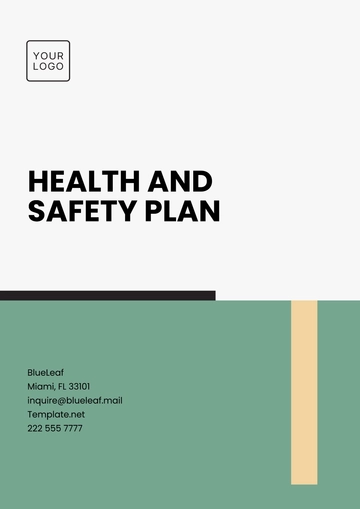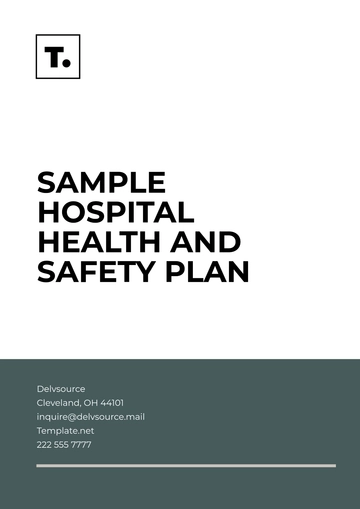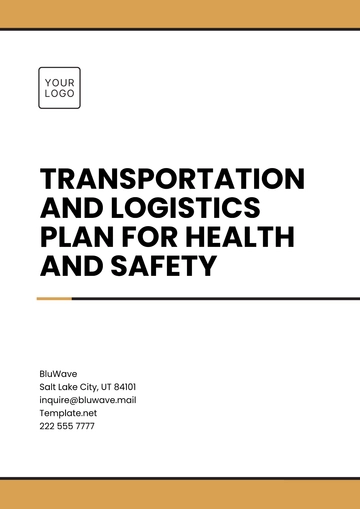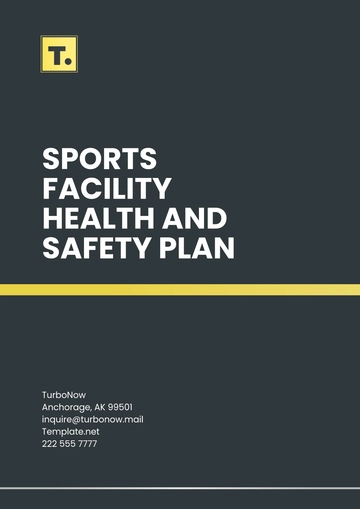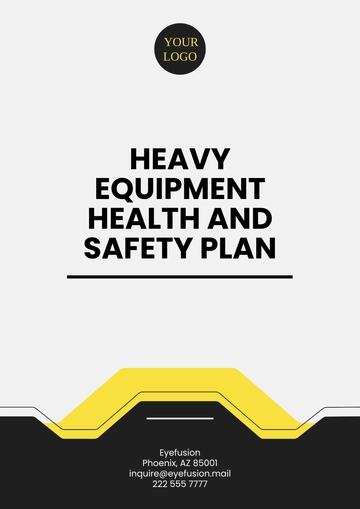Free Playground Safety Security Plan

Ensuring the safety and security of playgrounds is paramount for providing a fun and risk-free environment for children. This comprehensive plan outlines strategic measures for maintaining physical safety, enhancing security protocols, and promoting awareness among stakeholders, including parents, caregivers, and local communities.
I. Risk Assessment and Hazard Identification
A thorough risk assessment is the foundation of playground safety. Identifying hazards is essential to creating a safer environment for children and mitigating potential risks.
A. Inspection Procedures
Routine Inspections:
Conduct weekly playground checks focusing on wear and tear of equipment, surfaces, and play structures.
Document findings in a maintenance log to track issues and repairs.
Comprehensive Inspections:
Execute detailed quarterly inspections by certified safety inspectors to evaluate structural integrity, safety compliance, and adherence to local safety codes.
Include checklist evaluations based on industry standards to ensure all safety aspects are covered.
B. Hazard Identification
Key hazards include:
Faulty Equipment: Regularly check for broken swings, slides, and climbing structures that may pose injury risks.
Inadequate Surfacing: Ensure all play areas have appropriate shock-absorbing surfaces to minimize injury from falls.
Environmental Risks: Identify and mitigate risks from uneven ground, proximity to busy roads, and nearby hazardous structures or materials.
II. Safety Protocols and Equipment Standards
Implementing robust safety protocols and adhering to established equipment standards is crucial for maintaining playground safety.
A. Equipment Standards
Compliance with Standards:
Ensure all play equipment meets ASTM International standards and U.S. Consumer Product Safety Commission (CPSC) guidelines for public playgrounds.
Maintain an up-to-date inventory of equipment compliance certifications and manufacturer recommendations.
Maintenance and Repair:
Establish a routine maintenance schedule for inspections and repairs to prevent accidents.
Engage qualified personnel for repairs and replacement of damaged equipment.
B. Surfacing and Fall Zones
Utilize shock-absorbing materials such as wood chips, sand, or rubber mats to effectively reduce the severity of injuries from falls.
Maintain appropriate fall zones around each piece of equipment, following recommended guidelines (e.g., CPSC guidelines) to ensure adequate spacing and depth of materials.
III. Security Measures
Protecting children through comprehensive security measures is essential for preventing unauthorized access and ensuring a secure play environment.
A. Surveillance Systems
CCTV Installation:
Install high-resolution CCTV cameras to monitor playground activity 24/7, ensuring clear visibility of all play areas.
Display signage indicating the presence of surveillance cameras to deter unauthorized access and encourage safe behavior.
Controlled Access Points:
Implement controlled access points with gates or barriers that can be locked during non-operational hours.
Designate a specific entrance and exit to monitor the flow of visitors and enhance security.
B. Staff Training and Supervision
Provide regular training for staff on security protocols, emergency procedures, and child protection measures.
Ensure adequate supervision during operational hours, maintaining a staff-to-child ratio that promotes active monitoring and engagement.
IV. Emergency Preparedness and Response
An effective emergency response plan ensures prompt action during unforeseen incidents, safeguarding children and staff.
A. Emergency Equipment
Accessible First Aid Kits and AEDs:
Install first aid kits and automated external defibrillators (AEDs) in easily accessible locations throughout the playground.
Conduct routine checks to ensure all emergency equipment is available, fully stocked, and functional.
Emergency Communication Systems:
Equip staff with mobile communication devices to facilitate immediate contact with emergency services when necessary.
Establish a clear communication plan for alerting parents and guardians in case of emergencies.
B. Emergency Procedures
Develop and regularly update evacuation plans and procedures for various emergency scenarios, including severe weather conditions, medical emergencies, and security threats.
Conduct regular drills with staff and children to familiarize them with emergency protocols and response actions.
V. Awareness and Education Programs
Promoting awareness among parents, children, and local communities enhances playground safety and security through active participation and education.
Parental and Community Involvement
Workshops for Parents and Caregivers:
Conduct interactive workshops on playground safety, emphasizing the importance of supervision and safe play practices.
Provide informational materials on recognizing hazards and encouraging safe behavior among children.
Community Watch Programs:
Initiate community watch programs that encourage local participation in monitoring playground safety and reporting suspicious activities.
Foster partnerships with local organizations and schools to enhance community engagement and support.
B. Children's Education
Implement age-appropriate safety education programs that teach children about safe play practices, recognizing hazards, and understanding the importance of following rules.
Use fun, interactive methods such as storytelling, games, and role-playing to engage children in safety education.
VI. Evaluation and Continuous Improvement
Regular evaluation of safety measures ensures effectiveness and fosters continuous improvement in playground safety.
A. Monitoring and Feedback
Surveys and feedback mechanisms:
Conduct surveys and gather feedback from parents, staff, and children on the effectiveness of safety measures and protocols.
Use feedback to identify areas for improvement and implement necessary changes.
Incident Reporting System:
Establish a system for reporting and documenting safety incidents or near-misses to analyze patterns and improve protocols.
B. Regular Updates and Reviews
Regularly update safety and security protocols based on new guidelines, best practices, or following significant incidents.
Schedule annual reviews of the safety plan to ensure alignment with current safety
- 100% Customizable, free editor
- Access 1 Million+ Templates, photo’s & graphics
- Download or share as a template
- Click and replace photos, graphics, text, backgrounds
- Resize, crop, AI write & more
- Access advanced editor
Ensure a safe play environment with our Playground Safety Security Plan Template. This customizable template provides a comprehensive framework for assessing and enhancing playground safety measures. Easily downloadable and printable, it allows for quick implementation. Plus, it's editable in our AI Editor Tool, enabling you to tailor the plan to your specific needs.
You may also like
- Finance Plan
- Construction Plan
- Sales Plan
- Development Plan
- Career Plan
- Budget Plan
- HR Plan
- Education Plan
- Transition Plan
- Work Plan
- Training Plan
- Communication Plan
- Operation Plan
- Health And Safety Plan
- Strategy Plan
- Professional Development Plan
- Advertising Plan
- Risk Management Plan
- Restaurant Plan
- School Plan
- Nursing Home Patient Care Plan
- Nursing Care Plan
- Plan Event
- Startup Plan
- Social Media Plan
- Staffing Plan
- Annual Plan
- Content Plan
- Payment Plan
- Implementation Plan
- Hotel Plan
- Workout Plan
- Accounting Plan
- Campaign Plan
- Essay Plan
- 30 60 90 Day Plan
- Research Plan
- Recruitment Plan
- 90 Day Plan
- Quarterly Plan
- Emergency Plan
- 5 Year Plan
- Gym Plan
- Personal Plan
- IT and Software Plan
- Treatment Plan
- Real Estate Plan
- Law Firm Plan
- Healthcare Plan
- Improvement Plan
- Media Plan
- 5 Year Business Plan
- Learning Plan
- Marketing Campaign Plan
- Travel Agency Plan
- Cleaning Services Plan
- Interior Design Plan
- Performance Plan
- PR Plan
- Birth Plan
- Life Plan
- SEO Plan
- Disaster Recovery Plan
- Continuity Plan
- Launch Plan
- Legal Plan
- Behavior Plan
- Performance Improvement Plan
- Salon Plan
- Security Plan
- Security Management Plan
- Employee Development Plan
- Quality Plan
- Service Improvement Plan
- Growth Plan
- Incident Response Plan
- Basketball Plan
- Emergency Action Plan
- Product Launch Plan
- Spa Plan
- Employee Training Plan
- Data Analysis Plan
- Employee Action Plan
- Territory Plan
- Audit Plan
- Classroom Plan
- Activity Plan
- Parenting Plan
- Care Plan
- Project Execution Plan
- Exercise Plan
- Internship Plan
- Software Development Plan
- Continuous Improvement Plan
- Leave Plan
- 90 Day Sales Plan
- Advertising Agency Plan
- Employee Transition Plan
- Smart Action Plan
- Workplace Safety Plan
- Behavior Change Plan
- Contingency Plan
- Continuity of Operations Plan
- Health Plan
- Quality Control Plan
- Self Plan
- Sports Development Plan
- Change Management Plan
- Ecommerce Plan
- Personal Financial Plan
- Process Improvement Plan
- 30-60-90 Day Sales Plan
- Crisis Management Plan
- Engagement Plan
- Execution Plan
- Pandemic Plan
- Quality Assurance Plan
- Service Continuity Plan
- Agile Project Plan
- Fundraising Plan
- Job Transition Plan
- Asset Maintenance Plan
- Maintenance Plan
- Software Test Plan
- Staff Training and Development Plan
- 3 Year Plan
- Brand Activation Plan
- Release Plan
- Resource Plan
- Risk Mitigation Plan
- Teacher Plan
- 30 60 90 Day Plan for New Manager
- Food Safety Plan
- Food Truck Plan
- Hiring Plan
- Quality Management Plan
- Wellness Plan
- Behavior Intervention Plan
- Bonus Plan
- Investment Plan
- Maternity Leave Plan
- Pandemic Response Plan
- Succession Planning
- Coaching Plan
- Configuration Management Plan
- Remote Work Plan
- Self Care Plan
- Teaching Plan
- 100-Day Plan
- HACCP Plan
- Student Plan
- Sustainability Plan
- 30 60 90 Day Plan for Interview
- Access Plan
- Site Specific Safety Plan
